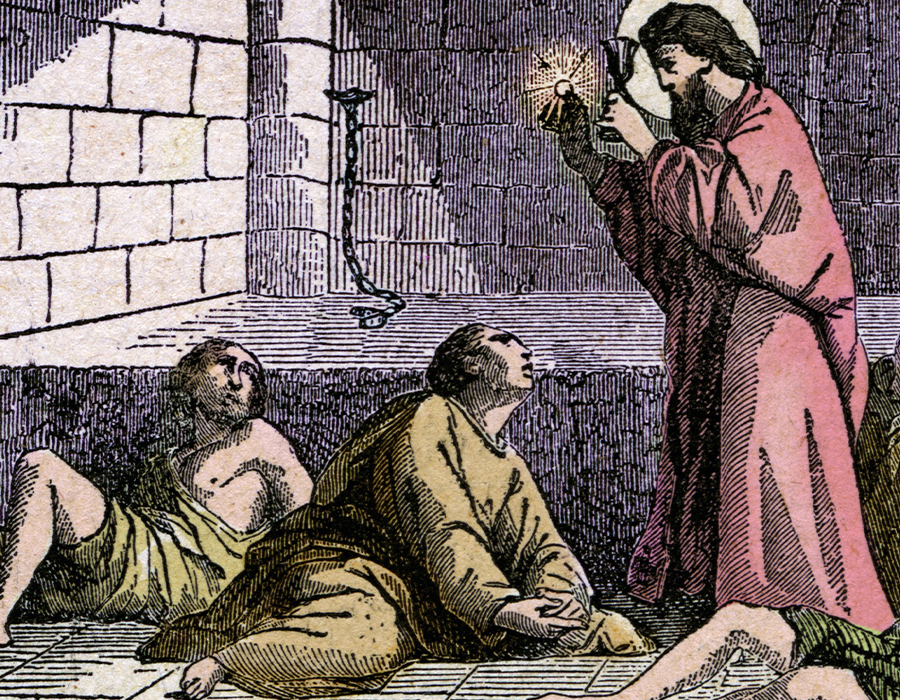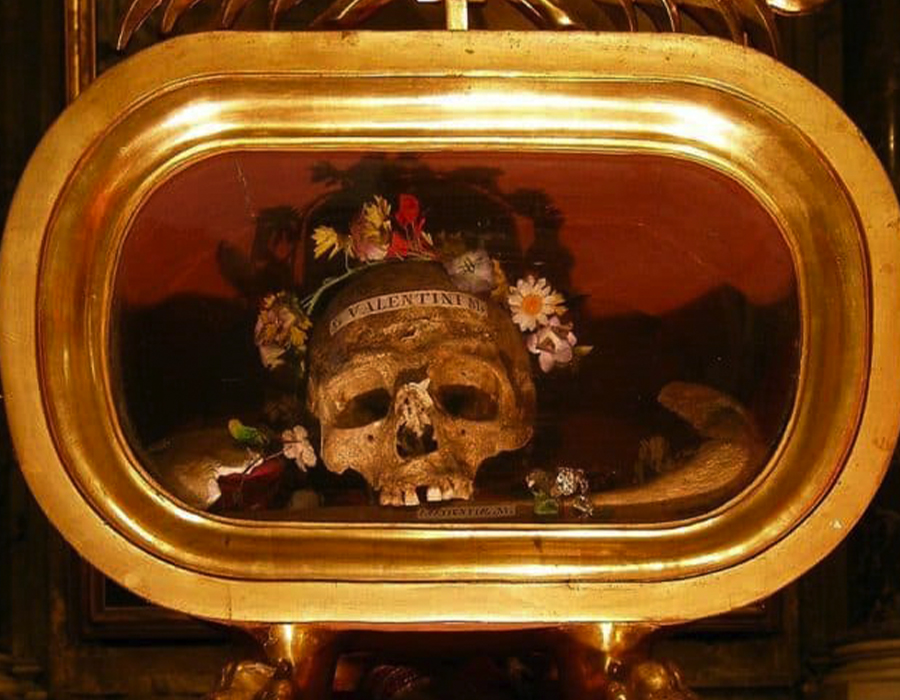
Saint Valentine, a name synonymous with love and affection, has been celebrated for centuries, not just as a cultural icon of romantic love but as a significant figure in Christian history.
Saint Valentine of Rome, or Valentinus as he would have been called in Latin, was martyred on February 14 in AD 269. Two centuries later, the Feast of Saint Valentine was established and celebrated on February 14 in his honor. Over time, the devotion spread into what many people (and greeting cards!) now refer to simply as Valentine’s Day.
But the true story about St. Valentine goes much deeper than roses and boxes of chocolate – much deeper, in fact, than human love. His legacy, deeply rooted in the tradition of the Catholic Church, offers a profound example of faith, courage, and the power of love in the face of adversity.
With (Saint) Valentine’s Day approaching, let’s explore the life, martyrdom, and Christian legacy of St. Valentine of Rome.
 The Life of St. Valentine
The Life of St. Valentine
St. Valentine, according to various accounts, was a priest in Rome or a bishop of Terni (in present-day Italy) during the third century. Living under the reign of Emperor Claudius II, a period marked by persecution of Christians, Valentine stood out for his unwavering commitment to his faith and his compassionate acts of love.
The most popular legend associated with St. Valentine recounts his defiance of Emperor Claudius II’s decree forbidding the marriage of young couples.
Claudius believed unmarried soldiers performed better on the battlefield, free from the worries of familial ties. However, Valentine, recognizing the sanctity of marriage, continued to secretly wed young lovers.
His actions, though illegal, underscored a profound belief in love as a core Christian value, embodying the words of 1 Corinthians 13:13, “And now these three remain: faith, hope, and love. But the greatest of these is love.”
Martyrdom and Canonization
Valentine’s clandestine ceremonies eventually led to his arrest. While imprisoned, he performed a miracle by healing his jailer’s blind daughter, further testament to his saintly virtues. Despite this miraculous act, Valentine was sentenced to death for his Christian faith and defiance of imperial edicts.
 The date of his martyrdom is believed to be February 14 around the year 269. Traditional accounts relate that he was beaten, stoned, and finally beheaded outside the Flaminian Gate of Rome.
The date of his martyrdom is believed to be February 14 around the year 269. Traditional accounts relate that he was beaten, stoned, and finally beheaded outside the Flaminian Gate of Rome.
After his execution, Valentine’s body was buried at what is now the Church of Praxedes in Rome. His grave became a pilgrimage site, and he was venerated as a martyr and saint by the early Christian Church. The Feast of St. Valentine, or Saint Valentine’s Day, was established by Pope Gelasius I in AD 496 to be celebrated on February 14 in honour of this Christian martyr.
Over the centuries, St. Valentine’s sacrifice for love and faith was honored by the Catholic Church, thereby also spreading into popular culture. Though his feast day was removed from the General Roman Calendar in 1969 due to the limited information about his life, St. Valentine is still venerated as a saint, and his feast is celebrated locally in various parts of the world.
Devotion and Legacy
The devotion to St. Valentine is marked by petitions for intercession in matters of love and marriage, reflecting his historical association with these themes. However, his legacy encompasses broader aspects of Christian life, including the virtues of bravery, compassion, and steadfastness in faith.

Beyond being the patron saint of lovers, St. Valentine is also considered the patron saint of engaged couples, happy marriages, love, plague, epilepsy, and beekeepers. This wide array of patronages reflects the various aspects of his legend and the miracles attributed to him.
Every year on February 14, Christians and non-Christians alike celebrate what has simply become known as Valentine’s Day, often with a focus on honoring and strengthening their relationships. For Catholics, the day also provides an opportunity to reflect on the meaning of true love as described in Scripture — selfless, enduring, and grounded in faith.
Relics of St. Valentine
The veneration of St. Valentine, a symbol of love and a martyr of Christianity, extends across the globe, with a number of churches and basilicas housing his relics. These sacred sites attract pilgrims and visitors who come to pay homage, seek intercession, or simply to learn more about the saint’s life and legacy.
Here are some of the most notable places where St. Valentine’s relics are venerated:
The Basilica of Santa Maria in Cosmedin, Rome
In the heart of Rome lies the Basilica of Santa Maria in Cosmedin, home to what is believed to be the skull of St. Valentine. The basilica, known for its beautiful architecture and the famous Bocca della Verità (“Mouth of Truth”) artifact, houses the relic in a side altar, adorned with flowers and tokens of devotion, especially around his feast day. Pilgrims and tourists alike visit this site to reflect on the life and martyrdom of St. Valentine, seeking his blessings for their relationships.
The Church of St. Praxedes, Rome
Another significant location in Rome that claims a connection to St. Valentine is the Church of St. Praxedes. This ancient church, known for its stunning mosaics and historical significance, contains a fragment of the saint’s relics. It serves as a place of prayer and meditation, where the faithful can feel a connection to the early Christian martyrs and their enduring witness to the faith.
 The Carmelite Church in Dublin, Ireland
The Carmelite Church in Dublin, Ireland
The Carmelite Church on Whitefriar Street in Dublin, Ireland, is perhaps one of the most famous sites of veneration for St. Valentine outside of Italy. In the 19th century, Pope Gregory XVI gifted the church with the saint’s relics, which now rest within a dedicated shrine.
Every year, especially on St. Valentine’s Day, couples flock to the church to celebrate Mass, receive blessings, and pray before the relics, seeking guidance and protection for their relationships. The church’s association with St. Valentine has made it a unique symbol of love and devotion in Ireland.
Basilica of Saint Valentine in Terni, Italy
Terni, the city often associated with St. Valentine’s bishopric, is home to the Basilica of Saint Valentine. This site is particularly significant as it is believed to be the final resting place of the saint.
The basilica hosts an annual festival and celebration in honor of St. Valentine, attracting visitors from across Italy and beyond. The church and its surroundings offer a profound space for reflection on the virtues of love, faith, and sacrifice, as well as a reminder of the sacrifice and legacy of this special saint.
The places of veneration dedicated to St. Valentine underscore the widespread devotion to this early Christian martyr and the universal themes of love and sacrifice that he represents.
Each site offers a unique perspective on the saint’s legacy, reflecting the universal appeal of his life and the courageous faith that led to his martyrdom, and reminding the faithful that true love is a gift from God which must be cherished, nurtured, and protected.
 Reflections
Reflections
In a world where the meaning of true love is often overshadowed by commercialism and superficiality, these places of veneration stand as beacons of hope, reminding us of the depth, sacrifice, and enduring power of love that St. Valentine’s life exemplifies.
St. Valentine’s story also encourages the faithful to perceive love not merely as an emotion but as an act of will directed towards the good of the other. It calls on Christians to love bravely and selflessly, mirroring the sacrificial love of Christ.
In an age where the notion of love is often reduced to sentimentality or sensuality, St. Valentine’s example is a powerful reminder of love’s true essence and its foundational place in Christian doctrine.
As we celebrate St. Valentine’s Day, let us remember the man behind the legend — a martyr of the faith who lived and died for love. May his devotion inspire us to nurture our relationships with the same courage, faith, and love that he demonstrated, making every day an opportunity to love as deeply, fearlessly, and faithfully as he did.
♥♥♥♥♥♥♥♥♥♥♥♥
Gifts for St. Valentine’s Day
See more in our St. Valentine Devotion section
 Engravable St. Valentine Rosary Bracelet
Engravable St. Valentine Rosary Bracelet
SHOP NOW
 SHOP NOW
SHOP NOW
 SHOP NOW
SHOP NOW
 SHOP NOW
SHOP NOW
 SHOP NOW
SHOP NOW
♥♥♥♥♥♥♥♥♥♥♥♥♥♥♥♥


